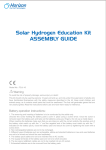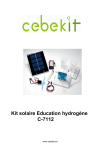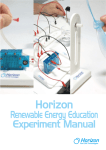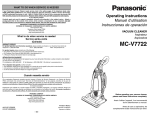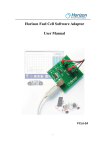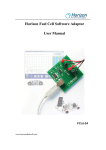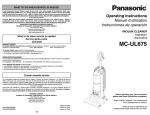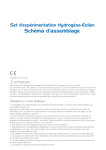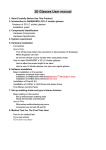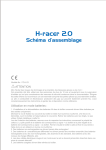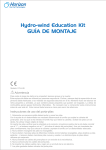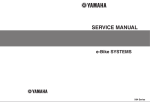Download Experiment manual
Transcript
RENEWABLE ENERGY science education set www.horizonfuelcell.com w w w. h o r i z o n f u e l c e l l . c o m Made in China Experiment manual User Manual & Experiment Guide Contents: Model no.: FCJJ-27 WARNING: To avoid the risk of property damage, serious injury or death: This set is intended for use only by person 12 years old and up, and only under the supervision of adults who have read and understood the safety and operating instructions contained in the set’s manual. Keep children under the age of 12 away as the set contains small parts that can be swallowed. Some configurations in the set generate gases that are very easily ignited. Do not use the set or any of its components for any other purposes than instructed in this manual. Read the instructions carefully before use and have them ready for reference. 1.Safety instructions: please read carefully before starting....................................... P01 2. Introducing the renewable energy opportunity...................................................... P02 3. About the renewable energy education set........................................................... P05 4. Discovering solar photovoltaic energy.................................................................. P07 5. Hydrogen: the “renewable” fuel of the future........................................................ P16 6. Using the fuel cell to convert hydrogen to electricity............................................. P26 7. Discovering wind energy....................................................................................... P37 8. Advice for optimal operation................................................................................. P57 9. Troubleshooting ................................................................................................... P58 Part 1. Safety Instructions: please read carefully before starting Part 2. Introducing the Renewable Energy Opportunity Renewable energy is unlimited clean energy To avoid the risk of property damage, serious injury or death: 1. Read carefully and fully understand the instructions before starting the assembly of this set. 2. This set is intended only for use by persons 12 years old and up, and only under the supervision of adults who have read and understood the instructions in this user manual. 3. When assembling this kit, tools may be used. Extra care should be taken to avoid personal injury. 4. Some parts are small and fragile: please be careful when handling and connecting parts to avoid breakage. Handle all parts and components with care. 5. Do not attempt to use any part, item or component provided in this set for any other purpose than what is instructed in this user manual. 6. Keep your hands and your body away from the turbine blades when it is rotating to avoid injury. 7. This product contains small parts. It is not suitable for children under 12 years old. 8. Please read carefully the battery pack operation instructions on page 60 before using the battery pack. 1 The International Energy Agency projects that the world's electrical power generating capacity will increase to nearly 5.8 million megawatts by the year 2020, up from about 3.3 million in 2000. However, the world's supply of fossil fuels - our current main source of electricity - will start to run out from the years 2020 to 2060, according to the petroleum industry's best analysts. Unlike fossil fuels, renewable energy sources will never run out. In one day, the sunlight which reaches the earth produces enough energy to meet the world's current power requirements for eight years. On a global average, each square meter of land is exposed to enough sunlight to produce 1,700 kWh of power every year. The average output is between 850 kWh/m2 in Northern Europe, 1,200 kWh/m2 in Central Europe and 1,200-2,000 kWh/m2 in Southern Europe and the Mediterranean. Nature offers a variety of options for producing renewable energy. It is mainly a question of how to convert sunlight, wind, biomass or water into electricity, heat or power as efficiently, environmentally friendly, and cost-effectively as possible. 2 Positive impact for our environment Renewable energy technologies, which include wind, solar, hydro, geothermal and organic bioenergy, are a lot friendlier to the environment than conventional energy technologies, which rely on fossil fuels. Fossil fuels contribute significantly to many environmental problems - greenhouse gases, air pollution, and water and soil contamination - while renewable energy sources contribute very little or not at all. Greenhouse gases (carbon dioxide, methane, nitrous oxide, hydrocarbons, and chlorofluorocarbons) surround the Earth's atmosphere like a clear thermal blanket, allowing the sun's warming rays in and trapping the heat close to the Earth's surface. This natural greenhouse effect keeps the Earth's average surface temperature at about 33°C (60°F). 3 Securing our energy Oil dependence has resurfaced as a concern that carries significant political and economic risks. This conventional energy source is vulnerable to political instabilities, trade disputes, embargoes and other disruptions. Because renewable supplies are predictable and abundant, they can also help stabilize energy costs and free consumers from the volatile price swings in the natural gas and oil markets due to supply and demand. Also, technological improvements and federal production incentives have made the cost of electricity from some renewable, more cost-competitive compared to generating power from conventional sources. In fact, technological improvements and market growth are making renewable sources are becoming more cost competitive. A positive impact for local economies Scientists believe the increased use of fossil fuels has significantly increased greenhouse gas emissions, particularly carbon dioxide, creating an enhanced greenhouse effect known as global warming. Both pollution and global warming pose major health risks to humans, as this contributes to lung disease, including asthma, lung cancer and respiratory infections. Some countries are using renewable energy as one way to encourage economic development and stimulate local economies. In many instances, money spent on energy leaves a community, going to outside utilities or energy suppliers. A significant global effort in clean energy technology research is developing to collect, store and deliver energy efficiently without harming our planet. By developing renewable energy sources, which often employ native resources and local production, energy money is spent in the local economy, helping to generate wealth locally. 4 List of parts: A. Propeller blade B. Double headed banana plug cable C. Electrolyzer D. Hydrogen tank E. Oxygen tank F. Gas containers G. Rubber tubes H. Screws and post secure pin I. Battery pack J. Red & black pin K. Syringe L. Motor & fan module frame M. Blade head assembly N. Main body O. Support base P. Wind turbine blades Q. Wind turbine mount R. Fuel cell S. Small car wheel T. Fuel cell base U. Electrolyzer base V. Water tank base W. LED base X. Circuit board module base Y. Solar panel Z. Adaptors, clincher & purging valve Part 3. About the Renewable Energy Science Education Set A The Renewable Energy Science Education Set is a modular experiment tool designed to demonstrate the workings of clean energy technologies on a miniature scale. With this set, an entire miniature renewable energy system can be constructed. The set is modular so that users can learn the system step by step, configure the system in different ways, and visualize the complete system from start to finish. Users can learn about direct renewable power generation using solar photovoltaic technology, experiment with electrolysis to generate and store hydrogen, and discover how hydrogen can be used as a renewable “energy carrier” that can power many applications via fuel cell technology. This set provides an excellent opportunity to learn about the exciting prospects of renewable energy, as well basic physics and chemistry principles. It shows how renewable energy can be harnessed, stored, and re-used in all kind of applications and how hydrogen can be the unique link between natural sources of power and power consuming devices - using fuel cell technology. Enjoy this exciting science education kit, and start building your own hydrogen powered world! B G L C H Q N R F J I M E D K O S P T U 2 1 4 3 V 5 W X Note: 1. Screwdriver and scissor are not provided in this set. 2. Alkaline AA batteries required when included battery power pack is used. 3. Distilled or purified water (H2O) not included Y Z 6 Part 4. Discovering Solar Photovoltaic Energy Creating electricity from sunlight: The Renewable Energy Education Set contains a solar photovoltaic cell that will be used in most of our experiments as a way to capture renewable energy from the sun. The word “photovoltaic” is a marriage of two words: “photo”, meaning light, and “voltaic”, refering to Volts of electricity. So photovoltaic (pv) technology, involves the generation of electricity from light. The secret to this process is the use of a semiconductor material which can be adapted to release electrons, the negatively charged particles that form the basis of electricity. The most common semiconductor material used in photovoltaic cells is silicon, an element most commonly found in sand. All pv cells have at least two layers of such semiconductors, one positively charged and one negatively charged. 7 When light shines on the semiconductor, the electric field across the junction between these two layers causes electricity to flow, generating DC current. The greater the intensity of the light, the greater the flow of electricity. Costs for solar photovoltaic power generation are still high, but have decreased over the past 20 years. New generations of solar pv technologies are emerging as a result of new materials research. Solar pv is quite different from a solar thermal system where the sun's rays are used to generate heat, usually for hot water in a house or swimming pools. In the next years, we may see inexpensive solar pv materials printed like newspapers on rolls of flexible film. Flexible solar pv materials are already being “rolled-out” on the rooftops of warehouses, and some of these warehouses are now able to supply energy back into the local power grid during energy demand peaks. 8 Experiment 1: Use a solar photovoltaic cell to power flashing lights Experiment 2: Use a solar panel to power a small fan and a small car wheel Find parts B, X, Y, W. Assembly of a small electric powered fan: Use the red and black cables (B) to connect the solar photovoltaic module (Y) to the multi-connection circuit board module (X). Use the red cable for the red input jacks, and the black cable for the black input jacks. Find one of the round adaptors (Z 1) and the electric motor module (L), connect the adaptor to the motor axis and press onto the axis. Make sure the adaptor is inserted all the way to the base of the motor axis and that the axis can rotate freely (see pictures A & B). Z1 Connect the flashing lights module (W) to the circuit board module (X) using the red and black cables (B). Use the red cable for the red input jacks, and the black cable for the black input jacks. A Z2 B Hold the propeller blade (A) and press it into the adaptor (Z 1). Make sure the propeller and motor axis are connected tightly and the blade can rotate freely (see picture C & D). Place the solar cell (Y) in direct, strong sunlight. 9 If you are in direct sunlight, you will see the lights start to flash as soon as you connect the last cable between the flashing lights module and the circuit board module. The lights will continue flashing as long as the solar cell is exposed to sunlight. It will stop working as soon as light weakens or disappears and start working when sunlight is back. C D 10 Assembly of a small electric powered car wheel: Disconnect the propeller blade from the motor module. Hold the one of the adaptors (Z 2), which is the two step body connector. Point the big hole to the motor axis and press it onto the axis. Make sure the adaptor is inserted all the way to the base of the motor axis, and the axis can rotate freely (see picture A below). Use the red and black cables (B) to connect the solar photovoltaic module (Y) to the multi-connection circuit board module (X). Use the red cable for the red input jacks, and the black cable for the black input jacks. Hold the small car wheel (S) and press it onto the adaptor. Make sure the wheel and the motor axis are connected tightly and the wheel can rotate freely (see picture B & C below). Connect the assembled blade or wheel module to the circuit board module (X) using the red and black cables (B). Use the red cable for the red input jacks, and the black cable for the black input jacks. A B C Note: The fan and wheel module needs more power to function; therefore it will only work if the solar panel is exposed to very strong sunlight. 11 12 Renewable Energy Systems If the solar panel is exposed to strong sunlight, the propeller blade or wheel will start moving immediately. The fan may need some assistance to get started: when connected, just flick the blade downwards with your finger and the propeller blade should continue to move on its own. The fan will continue working as long as there is sufficient sunlight. Conclusions: Direct solar power works as long as you have sunlight and good weather. This forms the basis for one of the fundamental constraints facing the widespread use of renewable energy power systems: the intermittent nature of renewable energy resources. The solution to this constraint is to store the energy generated by these inexhaustible, yet intermittent sources of energy. In the past various storage solutions have been employed, including batteries, flywheels, ultracapacitors, pumped-storage hydroelectric, and superconducting magnets. These solutions have had varying degrees of success, but all have significant disadvantages, such as self-discharge, high cost, and the use of toxic materials in their construction. There is an emerging, better, and more complete energy storage option: hydrogen. In our next section, we will see that hydrogen can be produced using solar pv cells as a way to “store” solar power, and can be used later as a fuel in a fuel cell to create electricity for a variety of applications. Indeed, hydrogen can “store” and “deliver” the energy from the sun for use at any time and at any place - not necessarily at the fixed location of the solar pv system. Hydrogen can be stored in small canisters and bottles, and bigger storage tank solutions are now being developed for automobiles. 13 14 Part 5. Hydrogen: the “Renewable” Fuel of the Future In the past, the limiting factors of renewable energy have been the storage and transport of that energy. With the combined use of an electrolyzer, a method of storing and transporting hydrogen gas, and a fuel cell, electrical power from renewable energy sources can be delivered where and when required. Hydrogen can be produced sustainably from renewable energy systems with no carbon dioxide emissions. An example of such a system is the use of a solar panel, a wind turbine or a micro-hydro generator to convert the radiant energy of sunlight into electrical power, which drives an electrolyzer. The electrolyzer breaks apart water producing hydrogen and oxygen gases. The hydrogen is stored for use by the fuel cell and the oxygen is released into the atmosphere. Thus when the sun shines, the wind blows or the water flows, the electrolyzer can produce hydrogen. A power system incorporating hydrogen from renewable sources and a fuel cell is a closed system, as none of the products or reactants (water, hydrogen and oxygen) are lost to the outside environment. Hydrogen is the most abundant element in our universe and carries the most energy per unit of weight. This carbon-free fuel can be produced either using traditional or renewable power sources such as solar or wind power. Once captured and stored, hydrogen can be converted back to usable energy in numerous applications, including cars. This means our every day fuel can be produced locally, and in unlimited quantities. Hydrogen is an outstanding energy carrier. When it is consumed in the fuel cell, the result is electricity and water. This water can then used to produce hydrogen and oxygen, making the cycle is continuous and natural, with zero emissions. There are many challenges to making this a reality of course and cost barriers need to be broken for renewable energy technologies, but these costs have been decreasing steadily over the years, and are projected to decrease much further - it's only a matter of time and further innovations. The water consumed by the electrolyzer is converted to gases. The gases are converted back to water. The electrical energy produced by the solar panel is transferred to chemical energy in the form of gases. The gases can be stored and transported, to be reconverted back to electricity. These systems are truly sustainable, for as long as there is sunlight there can be electrical power, available where and when required. 15 Around the world, several “Hydrogen Highway” projects are being developed and over 200 hydrogen refueling stations have already been built to service the first fuel cell cars. 16 What is electrolysis and how do electrolyzers work? Electrolysis is the use of electrical energy to produce a chemical change. In the renewable hydrogen cycle, electrical energy (from renewable resources) is used to break the bonds between the hydrogen and oxygen in the water, releasing them as elemental gases. Hydrogen is “stored“ renewable energy. An electrolyzer is a device that facilitates the electrolysis of water to produce hydrogen gas. Electrolyzers most commonly used today generate hydrogen at relatively low pressures (from nearly atmospheric pressure up to 200 pounds per square inch) and use a liquid alkaline electrolyte (KOH or NaOH). At these pressures, storage of large quantities of hydrogen requires extremely large storage vessels. One solution to this problem is to use a compressor to increase the hydrogen pressure. Magnified Proton Exchange Membrane (P.E.M.) Electrolyzer O2 H2 However, the energy investment required to pressurize hydrogen, as well as the maintenance of hydrogen compressors, makes this option difficult for a large-scale application of this technology. Furthermore, the operation of alkaline electrolyzers requires frequent maintenance that includes disposal and replacement of the highly caustic electrolyte. New approaches to water electrolysis include proton exchange membrane electrolyzers one of which is included in this kit (electrolyzer module) (C). Such an electrolyzer can be designed to electrochemically generate hydrogen at pressures of 2000 psi or greater, thus eliminating the need for mechanical compression. No caustic alkaline or acidic fluid electrolyte is required. Additional advantages of PEM electrolysis over alkaline electrolysis include lower parasitic energy losses and higher purity hydrogen output. PEM electrolysis is potentially a simple, sustainable, and cost-effective technology for generating, compressing, and storing hydrogen. 17 PEM Electrolyzer Side View Electrolysis using a Proton Exchange Membrane 18 Activities: Preparation of the electrolyzer module and solar powered hydrogen production Insert the electrolyzer (C) into the slot located on the electrolyzer base (U) (see A). Place the water container base (V) with the Horizon logo facing towards you. Use scissors to cut out two lengths of 2cm of rubber tubing from the long rubber tube (G) provided in the set. Place the black pin into one end of the 2cm rubber tube. Insert the hydrogen outer storage containers (D) into one of the round slots located on the water container base (V) (see D). Attach the short rubber tube with the black pin to the top nozzle on the hydrogen side of the electrolyzer (marked H2). Attach the other short rubber tube to the top nozzle on the oxygen side of the electrolyzer (marked O2) (see B). Insert the oxygen outer storage containers (E) into the other round slot on the same base (see E). A B C Note: Good ion conductivity is critical to the performance of the electrolyzer. In order to ensure good conductivity, the electrolyzer ’s membrane needs to be properly humidified. In order to humidify the electrolyzer, complete the following points: Find the syringe (K) and push in its plunger in to remove all air inside. Draw distilled water into the syringe. 19 Insert the two inner containers (F) into the hydrogen and oxygen outer containers (D & E) (see E & F). On the electrolyzer (C), insert firmly the syringe (K) nozzle into the upper nozzle tube on the oxygen side. Slowly push the plunger to let the water into the oxygen side of the electrolyzer (see C). Stop pushing on the plunger once the water starts to come out from the chamber of the electrolyzer (C). Disconnect the syringe (K) from the nozzle tube and attach the red pin to the tube. Let the electrolyzer settle for 3 minutes. D E F Note: There are two openings at the bottom of each of the inner containers (F). These openings allow for gas to escape the inner containers (F) into the outer containers to limit the amount of gas stored. Make sure these openings are not blocked by the raised plastic frame holding the inner containers (F). Push on the top of the inner containers (F) to be sure they fit firmly onto the plastic rim located at the bottom of the outer storage containers. 20 Use scissors to cut out one length of 16cm of rubber tube provided in this set. Use scissors to cut out another 16cm length of tube. Hold the clincher (Z3) and make the tube go through all the holes in the clincher (see F & G). - make sure the clincher is 4cm away from one end of the tube. - make sure the clincher is set to the open position (lets air through the tube) (see G). Connect one end of this tube to the top nozzle of the inner oxygen container. Connect the other end of the tube to the lower nozzle located on the oxygen side of the electrolyzer (see J). Pour about 40ml distilled or purified water into the outer hydrogen and oxygen containers respectively (reach the upper 20 marks on the outer container - see K). F G Connect the long end of the tube (furthest away from the clincher) to the nozzle of the inner hydrogen container (see H). Connect the short end of the tube to the lower nozzle on the hydrogen side of the electrolyzer (see I & J). J 21 H I K Note: The water filling container is not provided in this set. You can use any other water container, but make sure the container you use is clean. 22 Disconnect the red pin of the short tube on the oxygen side of the electrolyzer (see L). You should observe that water fills the inner container. Once it is full, connect the red pin back onto the short tube. The solar powered hydrogen production system is now ready and can produce hydrogen and oxygen in the water containers. Repeat the same step on the hydrogen side. If the water cannot flow into the inner container please see Note on page 20 to solve the problem. Place the solar cell in direct sunlight, and you will start to notice the water levels changing inside the inner containers, both in the oxygen container, and in the hydrogen container. These changing water levels show that gases are formed inside the containers: hydrogen is being produced on the negative side or “cathode” of the fuel cell, and oxygen is being produced on the positive side or “anode” of the fuel cell. The hydrogen produced will be twice the volume of the oxygen produced. The hydrogen production cycle is complete when bubbles start surfacing from the inner container. When bubbles start to appear, disconnect the solar panel from the electrolyzer. Activities: Measuring the hydrogen and oxygen production Electrolyzer data recording chart L M Connect the electrolyzer (C) to the solar panel (Y). Use the red cable for the red input jacks, and the black cable for the black input jacks (see M). Keep the system connected and exposed to the sun. ! 23 1. Do not cross the wires! If you insert a red cable into a black socket and a black cable into a red socket, the electrolyzer (C) could be permanently damaged. 2. The clincher must be set to “open” Make sure the clincher is open after the solar panel is connected to the electrolyzer otherwise the membrane of the electrolyzer could be punctured and damaged by the accumulated hydrogen pressure. 3. You need pure hydrogen! If the solar panel is placed directly in strong sunlight and you look closely at the electrolyzer (C), bubbles will form inside. Gas volumes produced and ratios Time (min) Volume of Hydrogen (ml) Volume of Oxygen (ml) Ratio (Hydrogen to Oxygen volume) 2 4 6 8 10 Goal of this experiment: Students will establish that hydrogen and oxygen are produced at a 2:1 ratio. 24 Part 6. Using Fuel Cells to Convert Hydrogen to Electricity Note: The hydrogen and oxygen storage systems used in this set are similar to those used in the Hydrocar and Fuel Cell Car Science kits also designed by Horizon Fuel Cell Technologies. For more information about these and other Horizon products, please visit www.horizonfuelcell.com. Our next experiments will demonstrate the use of hydrogen as energy storage and mobile “energy carrier” for fixed sources of renewable energy. Hydrogen generated from water using sun or wind can be used in a wide variety of electric powered applications when converted back to electricity using a special device called a fuel cell. In the case of this experiment kit, hydrogen can be captured using power from the sun, the wind, or from a battery. In reality, hydrogen can be formed using any kind of power, including all renewable energies (solar, wind,geothermal, wave power etc), fossil fuels such as natural gas, and nuclear power. What is a fuel cell and how does it work: A fuel cell is a device that can convert hydrogen and oxygen to electricity and water. The fuel cell is an assembly of advanced material layers where hydrogen and oxygen react with each other to generate electricity and water, without any combustion. Electric Circuit e e With today's technologies, the most cost-effective way to capture hydrogen is by reforming natural gas, but renewable technologies are developing quickly and technology costs have dropped significantly over the past decades. The future will see many more innovations in this field. Some advanced solar power installations are already providing power back into the power grid, which means that if electrolyzer were placed near solar power installations, some excess power streams can be diverted to the production of hydrogen through electrolysis. This means warehouses that already have solar panel installations to save costs on lighting and air conditioning, could also start producing hydrogen as a fuel for various needs, such as fleets of forklift trucks, delivery vehicles, or standby power systems. e e PEM fuel cell e e Fuel H2 (Hydrogen) 2H 2 e e O2 (Oxygen) H2 O2 O O 2 H 2O Heat e- O Air + Water Vapor Used Fuel Recirculates Flow Field Plate Flow Field Plate Gas Diffusion Electrode (Anode) Gas Diffusion Electrode (Cathode) Catalyst Catalyst Proton Exchange Membrane 25 magnified PEM fuel cell side view 26 Preparation of the fuel cell system Insert the fuel cell (R) into the slot on the fuel cell module base (T) with the Horizon logo facing you. Make sure the red jack on the fuel cell (R) is aligned with the red input jack on the fuel cell module base! Due to much higher efficiencies over combustion engines, and much longer run-times over batteries, fuel cells offer numerous advantages including zero carbon emissions and and high performance electric powered applications. Use scissors to cut out a 2cm long tube. Connect the green purging valve (Z4) to one end of this tube (see B). Make sure the tube is inserted all the way to the base of the valve. Serious interest in fuel cells did not begin until the 1960's, when they were used as power for man's first missions to the moon. Although fuel cells still provide electricity and water for today's space missions, this unique technology is now aimed at promoting a global transition to renewable energy sources. Connect the other end of this tube to the lower nozzle on the hydrogen side of the fuel cell (see C). Fuel cell cars that use hydrogen as fuel are called “zero emission vehicles.” If fuel cell cars were to use hydrogen produced by renewable sources of energy such as solar or wind power, the fuel supply would be unlimited and consumption of hydrogen through fuel cells would not create any waste nor air pollution. B zero emission technology (no CO2) higher efficiency than combustion engines longer runtimes than conventional batteries The Renewable Energy Science Education Set uses a Proton Exchange Membrane (PEM) fuel cell. It generates electrical energy by consuming hydrogen which reacts with oxygen from the air. If you look closely at the fuel cell (above), you will see it has air inlets that allow oxygen from our atmosphere to enter the cell (Hydrogen reaches the fuel cell from the opposite side). This fuel cell configuration is therefore also called an “air-breathing” fuel cell, absorbing oxygen from the air as if it was “breathing”. 27 A C Note: When the fuel cell is connected to electric loads, the purging valve will help eliminate “impure” gases (non-hydrogen gases) out of the tubing system and fuel cell, as well as trace amounts of water that may clog hydrogen circulation. By eliminating these gases, and tiny amounts of water from the system, you will notice that efficiency and performance of the power unit will visibly increase. 28 The fuel cell module is now ready to be connected to a hydrogen supply Hydrogen was produced in the previous experiment using solar energy. In later experiments, we will also show other forms of hydrogen production (using wind energy or batteries). Either way, you will need to connect the filled hydrogen container (using water electrolysis) to the fuel cell module in next step. You have now connected the fuel cell device to a hydrogen supply. Should the fuel cell already be creating electricity? Actually, the fuel cell will not convert hydrogen to electricity unless it is exposed to an electrical load, or a device that consumes electricity. This electrical load triggers the conversion of hydrogen to electricity, and all available hydrogen will be consumed by the fuel cell unless hydrogen access is clogged by other gases or water. Make sure the solar panel, wind turbine, or battery pack are disconnected from the electrolyzer and the hydrogen container is full. On the tube connecting the hydrogen container to the electrolyzer, press down on the clincher in order to block the gas flow in the tube (see D). The set contains 3 loads: a LED light (W), an electric fan (A) and a small car wheel (S). Disconnect this tube from the electrolyzer (see E), then connect it to the lower nozzle on the fuel cell, located below the purging valve connection (see F). Make sure the clincher remains closed during this process. Using the smallest red cable, connect to the red socket of the fuel cell (R) to the red socket of the fuel cell module base (T). Repeat the same step with the black cable on the negative side (see A). D E F Experiment 1: Power the LED light using a hydrogen fuel cell Connect the red cable (B) to the red socket on the LED module (W). Repeat the same step with the black cable on the negative side (black cable and sockets) (see B). Open the clincher to open the gas flow from the hydrogen supply to the fuel cell (see C). You will now see the lights start to flash. The fuel cell is now converting hydrogen and oxygen from the air to water and electricity to power the LED lights. A 29 B C 30 If the lights do not flash, give a slight push on the purge button on the purging valve (Z4) and quickly release it. Keep an eye on the level of hydrogen in the water container to make sure you don’t purge everything out - all you need to release a tiny amount! Note: This step may be used in any of the experiments at any time from this set if the the fuel cell does not appear to be generating electricity and hydrogen is still left in the container. ! Permanent damage could occur to the fuel cell if water reaches its membrane! Before the water enters the fuel cell you must press down on the clincher to stop the hydrogen flow (and water flow) in the tube. This effect is called water flooding and is a common problem in fuel cells. Before the water flows through the clincher, you have to press down on the clincher to close it. If by accident water has entered into the fuel cell, you need to dry the hydrogen side of the fuel cell . In order to try to accomplish this (it may not always work 100%), you need to follow these steps: 1. Disconnect the fuel cell from its hydrogen supply. 2. Remove the purging valve from the small tube attached to the fuel cell (see A). 3. Find the syringe (K) and pull the plunger to bring air into its chamber. Keep it in this open position. The flashing lights module is using Light Emitting Diode (LED) technology, which you can now see in most of your electronic devices (“power on” indicators, digital panels, mobile phone lighting etc… LEDs are produced using different crystal substrates and the latest LED light technology uses high-brightness white LEDs. LED's require much less electricity, and therefore consume much less hydrogen. 4. Insert the syringe nozzle into the small tube attached to the fuel cell (see B). 5. Push the syringe plunger with force to drive the water out of the fuel cell. Repeat this step several times until you can not see water coming out (see C). Fuel cells consume only the amount of hydrogen they need depending on the load they are connected to. We will see later that the hydrogen consumption rate increases greatly with the fan, which compared to the LED lights, consumes more power. 31 As the LED continues to consume the hydrogen from the inner container in the water tank, you will see the water in the outer container will flow slowly into the inner container and into the tube. The fuel cell continues to draw hydrogen to provide power to the lighting device and will start to draw in water once hydrogen is fully consumed. A B C 32 Experiment 2: Use the fuel cell to power a small electric fan Experiment 3: Use the fuel cell to power the wheel of a small car Disconnect the cables from the LED module and repeat the water electrolysis steps (see page 23) to produce a fresh supply of hydrogen, close the clincher and connect the hydrogen supply to the fuel cell. Disconnect the cables on the propeller blade module and repeat the water electrolysis steps (see page 23) to produce a fresh supply of hydrogen, close the clincher and connect the hydrogen supply to the fuel cell. Connect the black cable from the fuel cell module to the black jack on the assembled propeller blade module (see page 10 ). Connect the red cable from the fuel cell module to the red jack on the propeller blade module (see A & B). Make sure the wires are connected correctly (black on black / red on red). A B Disconnect the propeller blade from the motor axis of the electric motor module. Assemble the small car wheel on the electric motor module (see page 11). Connect the black cable from the fuel cell module to the black jack on the electric motor module. Connect the red cable from the fuel cell module to the red jack on the electric motor module (see C). Make sure the wires are connected correctly (black on black / red on red). C Make sure to your fingers away from the blade as it may start rotating quickly! Open the clincher to open the gas flow from the hydrogen supply to the fuel cell. The fan blade should now be rotating. ! If the blade does not rotate, give a quick push on the green purging valve button since impure gases may be in the tubes. Please see the purging instructions on page 31 for more information. You will notice that this small electric fan will consume hydrogen much faster than the flashing lights. With this experiment we can clearly observe that: the larger the power requirement, the more hydrogen is required in order to keep the device powered for the same amount of time. 33 Open the clincher to open the gas flow from the hydrogen supply to the fuel cell. The wheel will begin to spin quickly. If the wheel does not spin, push the button on the green purging valve attached to the short tube (see the purging instructions on page 31). Activity: You can compare the time the wheel, fan, and lights will operate using the fuel cell and the same amount of hydrogen. 34 Experiment 4: Use a fuel cell to power the propeller blade module and the LED light in parallel Repeat the water electrolysis steps (see page 23) to produce a fresh supply of hydrogen, close the clincher and connect the hydrogen supply to the fuel cell. Connect the multi-connections circuit board base (X) to the fuel cell (see A). Connect the LED lights module to the multi-connections circuit board base (see B). Connect the propeller blade or wheel module to the multi-connections circuit board base (X). Make sure the wires are not cross (see C). Open the clincher to open the gas flow from the hydrogen supply to the fuel cell. Both the blade and the lights will begin to operate. Make sure to your fingers away from the blade as it may start rotating quickly! If no success, push the button on the green purging valve attached to the short tube (see the purging instructions on page 31). The blade should then start to rotate and the lights will begin to flash. They will continue working as long as the hydrogen is supplied to the fuel cell. A B C The rate at which the hydrogen is consumed is now much faster than in other experiments. Imagine a fuel cell power system in a home with multiple appliances running: the more applications are drawing power from the fuel cell, the more hydrogen is needed. Preparing the fuel cell module If the fuel cell has not been used for a while and is not working well, the dry fuel cell membrane needs to be humidified using a short circuit method. Follow these steps to reactivate the fuel cell. 1. Disconnect the hydrogen tube and the short tube with the black pin from the electrolyzer. 2. Connect one end of a rubber tube (cut a 5cm long tube) to the upper nozzle of the fuel cell, and the other end of this rubber tube to the electrolyzer. Connect the electrolyzer to the power source to make it produce hydrogen (see A). 3. Use the red wire with the double headed banana plugs, connect one end to the red jack and the other end to the black jack on the fuel cell. Place the fuel cell standing up vertically (see B). 35 A 4. Keep the wire connected for 3 minutes, and then disconnect. The fuel cell will now be ready for use. B 36 Part 7. Discovering Wind Energy Basic knowledge of wind power technology A wind turbine is a device that uses rotor blades connected by a mechanical shaft to an electrical alternator to generate electricity. When the wind blows across the rotor blades, the propeller shaft rotates the alternator and the alternator makes electricity (much the same when your car’s engine spins the alternator to charge the car’s battery). As wind energy gains more and more interest, an increasing number of wind turbine designs are being introduced today. Generally these turbines are comprised of the same basic parts: a tower, rotating blades, and gears. The amount of power that is produced by a wind turbine depends on many factors – one of which is the rotor blades. The power that can be harvested in the area swept by the wind turbine rotor blades can be described as follows: Albert Betz was a German Physicist and a pioneer of wind turbine technology. Betz found out that we can only harvest, at maximum, 16/27 or 0.593 of the power from the wind. This number is called the Betz coefficient and is the theoretical maximum efficiency that a wind turbine can harvest from the wind. In real world, we have to take into account many other factors that affect the wind power being converted into electrical power by the wind turbines. The efficiency of wind turbines is affected by the blade parameters, generator efficiency and the mechanical losses in the gear box, etc. P = 0.5*ρ*A*V³ If wind speed decreases by half (1/2), the power generated decreases by 1/8th of the original force. As a light wind contains little force, remember to use a larger table electric fan for the experiments. It will produce much better results. P = Power in Watts ρ= Air Density in Kg/m³ (about 1.225Kg/m at sea level) A = Rotor Swept Area in m² = πr² (r= radius of the rotor) V = Wind Speed in m/s Tower You should notice that the power is proportional to the cube of the wind speed and the square of the radius of the rotor blades. If the radius of the rotor blades is doubled, the swept area is quadrupled. 37 38 How do wind turbines turn wind into electricity? Drag and aerodynamics Generally, wind turbines function by the moving air pushing against the angled blades. This in turn causes the blades to spin, turning the turbine and therefore using the energy from the wind at a specific location. These blades convert the energy into rotational energy, as the blades are connected to a low speed shaft. This shaft is then connected to gears for converting the low speed rotation to high-speed rotation, suitable for generating electricity. Inside the gearbox, a large slow moving gear is connected to a small fast moving gear, which in turn is connected to a generator. As this generator turns it produces electricity. This electricity must then be converted to the correct voltage in a transformer before it is distributed and transmitted to other locations. Drag is defined as the force on an object that resists its motion through a fluid. When this fluid is a gas such as air, the force is called aerodynamic drag, or air resistance. Aerodynamics are an important consideration when studying wind turbines, as aerodynamic drag will decrease the efficiency of wind turbines. As turbine blades rotate with the wind and spin the motor drive shaft, the mechanical force that slows down the system can reduce the amount of power generated. Therefore, increasing the efficiency and reducing the drag on the moving blades is key to generating the maximum amount of power from wind turbines. The efficiency of wind turbines is dependent on the wind speed. If the wind is too strong the blades cause turbulence reducing efficiency. Stronger winds are generally found in higher altitudes, but ground contours around the turbine can help to channel the air movement to a particular location. Air movement is difficult to control and can come in the form of wind gusts or constant blowing. Due to the flat nature of large areas of water, air movement is more constant and therefore more efficient (optimal efficiency creates opportunity for hydrogen generation, as we will see later). This means the positioning of a wind turbine is vital for efficient use of this technology. These are the main ways to reduce drag in wind turbine systems: - changing the pitch or angle of the blades - using fewer blades - employing light weight materials to reduce the mass of the blades - using smooth surfaces on the blades as rough surfaces create more friction with the air - optimizing the shape of the blades to be more aerodynamic. There are several different types of wind turbines of various shapes and sizes. They can be separated into two types based on the axis on which the turbine rotates. Vertical-axis turbines are less frequently used. Each type of wind turbine has its advantages and disadvantages, and the type most commonly used for commercial applications are Horizontal Axis Wind turbines (HAWT). 39 40 Operating instructions for the experimental wind turbine included in this kit. This experimental wind turbine is designed to harness and demonstrate power from the wind in a laboratory environment. Using water electrolysis, the hydrogen and oxygen produced with this set can be used by a fuel cell to power small electronic devices, such as a small motor, fans, LED lights etc. The wind turbine comes with a set of 6 blades and 1 vane. In order to harvest the maximum power from the wind, the blade parameters need to be adjusted. At low wind speed, you need a larger number of blades, and thicker and longer size blades will generate more power. At high wind speeds, a smaller number of blades, and thinner and shorter size blades will be better. The objective is to allow the wind to turn the shaft of the generator at a maximum speed. The vane will automatically align the turbine to the direction of the wind to harvest the maximum wind power. You may also design your own blades and vanes with easily available plastic or paper card sheets to customize your Mini Wind Turbine. Scissors and Punch are the standard stationery needed to work with your imagination to create your own blades and vanes. You can modify the number, size and shape of the blades or vane to observe the effects on output of electricity from the wind turbine using the Horizon Fuel Cell Software Adaptor Kit (for live visualization on your computer) or a standard multi-meter. For more information about the Horizon Fuel Cell Software Adaptor Kit visit http://www.horizonfuelcell.com/store.htm 41 Our optional analog Horizon Fuel Cell Software Adaptor Kit (FCJJ-24)is a great addition to monitor the output of the mini wind turbine and test the wind turbines current, voltage, and power characteristics. The software adaptor allows you to compare the efficiency of the setup in a particular wind speed environment. The higher the output voltage, the more power you can harvest from the wind. Wind turbine specifications: Power Capacity (@ Rotor speed of 2000 rpm): - 1W Direct Output Voltage (@ Rotor speed of 2000 rpm): - DC 10V Direct Output Current (@ Rotor speed of 2000 rpm): - DC 100 mA Direct Output Voltage (@ Rotor speed of 1000 rpm): - DC 5V Direct Output Current (@ Rotor speed of 1000 rpm): - DC 50 mA Start-Up (Rotor start to turn) Wind Speed: - 3.5 mph (1.6 m/s) Cut-In (Generator starts to generate electricity) Wind Speed:- 5 mph (2.2 m/s) 42 Preparation of the electrolyzer module with the wind turbine Take the three nuts (H) and the blade head assembly (M) out of the packaging. Disconnect the blade base and the blade head. Hold the blade base and arrange the bottom facing upwards. Place the three nuts into the holes of the blade base (see 1A). Make sure the three nuts are inserted all the way into the holes of the blade base and that they are aligned with the outer surface of the holes (see 1B). Install the blades (P) on top of the nuts placed alternately on the blade base (see 2A). You can choose the long blades or short blades provided in this kit, depending on wind conditions. Please see the related information on page 37. After installation, place the base on a flat surface. The blades should not touch the surface. If the blades are not positioned correctly then disconnect the blades, install them facing the opposite direction. Place the blade head on the blade base (see 2B). Make sure the screw holes in the top of the blade head are aligned with the blade base. Make sure the three nuts are inserted alternately (see 1B). 43 1A 1B 2A 2B 44 Install the 3 long screws (H) through the holes on the blade head with the nuts (H) on the back side of the blade base (see 3A). Prepare the blade head and the main body in hand. Position the shaft on the main body towards the shaft hole on the blade base. Plug the blade unit into the shaft on the main body (see 4A). Use a long screwdriver (not provided) to secure the screws tightly (see 3B). Make sure you press the blade unit all the way into the shaft meanwhile turning the blade head. Check that the blade unit is securely positioned onto the shaft of the turbine (see 4B). Make sure that the nuts are aligned with the plastic casing when you secure the screws. 3A 3B 4A 45 4B 46 Place the wind turbine mount (Q) into the opening hole on the support base (O) (see 5A). Make sure the hole on the wind turbine mount is aligned with the hole on the base. Install the body assembly on the top of the wind turbine mount and secure it with the screw (H) (see 6A & 6B). Insert the post secure pin into the hole on the base (see 5B). Make sure the pin is also inserted into the hole in the wind turbine mount (see 5C). 5A 5B 5C 6A 47 6B 48 Push the red & black buttons outwards on the bottom of the main body. Insert the banana plugs of the red & black connecting cables into the red & black plugs respectively. Release the button to securely clamp the cables onto the wind turbine. Make sure the red cable is connected to the red positive side and the black cable is to the black negative side. Experiment 1: Use a wind turbine to power an LED light Connect the black cable from the wind turbine to the black jack in the LED light module. Connect the red cable from the wind turbine to the red jack in the LED light module (see A). Position the wind turbine in the face of strong winds outside or in front of an electric fan placed on a table indoors. If oustide winds are insufficiently strong, use the electric fan. Turn on the electric fan to make the wind turbine rotate quickly, the LED light should now be flashing continuously (see B). A B Experiment 2: Use a wind turbine to power the small car wheel Power off the electric fan providing wind to the wind turbine, or move the turbine away from its wind source. Disconnect the cables from the LED light module. 49 Your wind turbine is now ready to capture power from the wind! Connect the small car wheel assembled in the previous experiments to the wind turnbine (see C). Make sure the cables are connected in the correct way (red on red, black on black). Turn on the electric fan to make the wind turbine rotate quickly. You will see nothing happened to the small car wheel (see D). 50 Use the wind turbine to turn wind energy into hydrogen Prepare the electrolyzer and water containers according to previous experiments on pages 19 - 23. Connect the red and black cables from the wind turbine to the electrolyzer (C) being careful to match up red plug with the red socket and black plug with the black socket. If you cross the wires, or do not connect these cables correctly, the electrolyzer (C) could be permanently damaged Position the wind turbine in the face of strong winds outside or in front of an electric fan placed on a table indoors. If oustide winds are insufficiently strong, use the electric fan. The wind turbine blades should now be spinning quickly. C D Look closely at the electrolyzer (C), you will notice water is slowly being displaced. If there is no sufficient natural wind you can use the common desk fan to perform the electrolysis process. Conclusion: The power generated by this wind turbine can power the small LED light, but it can not power the small car wheel connected to the motor module, which means the small car wheel needs to draw more power than the small LED light while the wind turbine can not provide. You can use the software adaptor kit FCJJ-24 to measure the power, voltage, current of the LED light and the small car wheel generated by the wind turbine in front of a electric fan. Please visit http://www.horizonfuelcell.com/store.htm for more information about the software adaptor kit. 51 In the next experiment, we will see that hydrogen can be produced using power from the wind turbine - as a way to store wind energy. This stored hydrogen can be used later as fuel in a fuel cell which has enough power to turn the car wheel. This will demonstrate hydrogen as an energy carrier from intermittent renewable sources of power. 52 It should take 10-30 minutes to create enough hydrogen for our next experiments. You will know the hydrogen container is full when bubbles start overflowing into the main water tank. Using the battery pack to perform electrolysis (in case of no sun or no wind) Once hydrogen production is completed, power off the electric fan providing wind to the wind turbine, or move the turbine away from its wind source. Find the battery power pack (I) and make sure the power switch is in the “off” position. Use a screwdriver to open the empty battery pack and insert 2 AA batteries into the casing, then close the lid by replacing the screws onto the battery pack. Disconnect the red and black cables from the electrolzyer, and place the wind turbine aside. Go to the “Fuel cell system prepartion” on page 28 to use the wind-generated hydrogen to supply a fuel cell and power LED lights, a small electric fan, and a small electric car wheel. Conclusion: In this experiment, we show that whereas the small car wheel could not be powered directrly by the wind turbine, it could however, be powered by the fuel cell using hydrogen collected during wind-powered electrolysis. Hydrogen carries energy from the wind, and can be consumed at a faster rate by a more powerful fuel cell able to deliver enough power to drive the small car wheel. We can therefore use hydrogen fuel cell technology as an intermediary step to deliver energy in a different location, at a different time, and consumed for higher or lower power needs. Connect the red plug of the battery pack (I) to the red input jack of the electrolyzer (C). Connect the black plug of the battery pack (I) to the black input jack of the electrolyzer (C). Make sure this connection is absolutely correct (see picture below). Any other connection will permanently damage your electrolyzer module. Turn the battery pack (I) on, and watch closely as water is displaced in the water tanks (D&E) and small bubbles start appearing. You will notice that they appear faster than by using the solar panel, as the output power of the battery pack is higher than that of the solar cell or the wind turbine. Turn off the battery pack after 10 minutes of connection to the electrolyzer or you will consume all your batteries and damage your electrolyzer! Note: Read the battery pack operation instructions on page 60 carefully before use. 53 54 It should take 5-8 minutes to create enough hydrogen for our next experiments. You will know the hydrogen container is full when bubbles start overflowing into the main water tank. Once hydrogen production is completed, power off the battery pack. Disconnect the red and black cables from the electrolzyer, and place the battery pack aside. Go to the “Fuel cell system preparation” on page 28 to use the battery generated hydrogen to supply a fuel cell and power LED lights, a small electric fan, and a small electric car wheel. Create your own fuel cell powered application! Use the hydrogen and oxygen storage system to power the applications of your imagination. You can remove the propeller blade from the motor and use this motor as your mechanical drive. Remember to keep your power requirements low as this will reduce the drain on hydrogen. Feel free to submit pictures and comments on your application developments to [email protected] for our feedback. Additional Experiments: You can use Horizon Fuel Cell software Adaptor FCJJ-24 (not included) to visualize experiments on you screen or to measure the fuel cell performance before and after the hydrogen purging process to have a clear view of the impact of this process on the fuel cell. Also you can use Horizon Fuel Cell Software Adaptor FCJJ-24 to perform your additional experiments. You can purchase the Horizon Fuel Cell Software Adaptor FCJJ-24 at http://www.horizonfuelcell.com/store.htm for more information about this tool. 55 ! 1. As the electrolyzer keeps producing hydrogen and oxygen, its membrane becomes slightly warm. It is advised not to produce hydrogen and oxygen continuously for more than 10 minutes at a time or the electrolyzer will be permanently damaged. 2. After the electrolyzer produces hydrogen and oxygen continuously for nearly 10 minutes, disconnect it from its power source. Inject some distilled or purified water into the oxygen side of the electrolyzer to humidify the membrane for about 3 minutes (see page 19). 3. DO NOT ALLOW WATER TO ENTER THE FUEL CELL! Once the electrolysis is completed and a load is connected, the hydrogen in the container will be continuously consumed by the fuel cell until no hydrogen is left. Once all the hydrogen is consumed you will notice water will slowly flow out of the container into the fuel cell. The fuel cell will be damaged as the water flows into the fuel cell. Press down on the clincher to stop the water flowing or disconnect the load so the fuel cell can stop consuming hydrogen. If the water reaches the fuel cell membrane, electricity generation will stop. You have to use the syringe to push water out of the fuel cell (see page 32). 4. DURING ELECTROLYSIS, MAKE SURE THE CLINCHER IS ON THE OPEN POSITION (letting air pass into the tube.) Clinching the hydrogen tube that connects the hydrogen supply container to the electrolyzer will create accumulated hydrogen pressure which will puncture and damage the electrolyzer’s membrane. 5. Using non-distilled water will damage the electrodes of the fuel cell. Fuel cells use nano-scale or carbon supported platinum as a catalyst, and these particles are very sensitive to impurities found in non-distilled water. It is highly recommended to use the distilled or purified water. 6. For the purpose of this science education set, high quality drinking water or tap water with low mineral content can also be used - however the set’s lifetime will be shortened. 7. The electrolyzer must ONLY be hydrated through the oxygen (positive side) and not through the H2 side, failure to do so will result in the blockage of the hydrogen flow and failure of the experiments. 8. Carefully read the battery pack operation instructions before use (see page 60). . 56 Part 8. Advice for Optimal Operation 1. Make sure you use distilled or purified water only. Any other water will contain substances and minerals that can contaminate and destroy the fuel cell. If you notice the fuel cell starts oxidating – this means the appropriate water (distilled or purified water) was not used for your experiments. 2. Make sure the fuel cell is well hydrated before any electrolysis operation by filling it with water using the syringe. 3. You will have maximum performance when the entire electrolysis process is repeated three to four times. This is due to the increased hydration of the PEM membrane in the fuel cell after repeated use. Optimal temperature: 20°C - 30°C. Make sure the outer containers are filled with distilled water to the 20 ml mark on the outer containers before proceeding with electrolysis. 4. Ensure that the small outlets on the inner containers are not blocked by the plastic rim on the bottom of the outer container. Hydrogen and oxygen are lighter than water so they flow to the top of the inner container, displacing the water. If these small holes are blocked, too much pressure will build up inside fuel cell and this will cause damage to the fuel cell. 57 Part 9. Troubleshooting A. The water levels do not drop when the gas outlet tubes on both sides of the fuel cell are unplugged. Solution: Check whether the holes on the wall of the inner container are blocked. If so, turn the inner container until water enters the holes and fills up the inner container. B. The electrolyzer does not produce hydrogen and/or oxygen. Solution 1: Check whether the wires are appropriately connected, and whether there are any loose connections. The fuel cell could be completely destroyed if the red wire of the battery pack is connected to the black jack of the fuel cell. Solution 2: Replace the old batteries with new one in the battery pack. C. The load can not work while there is hydrogen left in the inner container. Solution: Push the green purging valve to release tiny amount of hydrogen (see page 31). You can then observe the load working well again. 5. When you run the fuel cell multiple times, water in the upper part of the outer container might not descend to the inner container. This is because a vacuum has been created in the tubing. Disconnect the tubing from the upper nozzle of the fuel cell and the water will descend into the inner container appropriately. D. The water electrolysis process slows down. Solution: Inject water to the oxygen side of the fuel cell by using the syringe and wait for about 3 minutes before using the electrolyzer again. 6. The fuel cell in the open air is very sensitive to volatile organic compounds, which will affect its performance. So when you finish using the kit, it is highly recommended to place the fuel cell inside an airsealed plastic bag, such as a “Ziploc” bag. This will protect the fuel cell while you are not using your kit. E. The wind turbine’s blades can not rotate properly or hit the wind turbine mount while rotating. Solution: Disconnect the blades, install them facing the opposite direction as on page 44. 58 F. No hydrogen is produced using the windturbine outdoors. Solution: If the wind speed is not sufficient electricity will not be created. Use a common desk fan with faster wind speed to perform the electrolysis using the electrolyzer, or conduct the experiment under stronger wind conditions. G. If the fuel cell and electrolyzer drop into the water. Solution: 1. Use the hair drier to blow hot air towards the fuel cell and the nozzles on each side. Make sure you blow warm air towards the fuel cell, feel the air temperature with your hand first to make sure the air is no too hot. Solution: 2. Use the syringe to push the water out of the fuel cell. See more instructions on page 32. H. The fuel cell can not generate electricity while there is hydrogen still left in the hydrogen container. Solution: 1. Push the purging valve to release tiny amount of hydrogen. See more instructions on page 31. Solution: 2. Use the syringe to push the water out of the fuel cell. See more instructions on page 32. ! Battery pack operation instructions: 1. The removing and inserting of batteries is to be conducted by the adults only. Unscrew the screw holding the battery pack’s cover in place using a screw driver. Once the screw is removed open the battery pack and take out the batteries using your fingers. Do not use a metal object. When inserting the batteries make sure that you are doing so with the correct polarity (the positive end of the battery must match up with the “+” and the negative end of the battery must match up with the “-” sign indicated on the battery pack), close the battery pack and secure its cover by tightening the screw with a screw driver. 2. Non-rechargeable batteries are not to be recharged. 3. Different types of batteries such as rechargeable, alkaline and standard batteries or new and used batteries are not to be mixed and should be used separately. 4. The battery pack cables are not to be inserted into an AC socket. 5. The supply terminals of the battery pack are not to be short-circuited. 6. The two spare red & black cables are not to be inserted into an AC socket. 7. Exhausted batteries are to be removed from the battery pack. contact [email protected] or visit www.horizonfuelcell.com for more information. 59 60
































